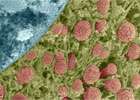Mitochondria (red) in the cell cytoplasm. Credit: Dr David Furness, Wellcome Images
Hailed as the ‘powerhouses’ of the cell in thousands of textbooks, mitochondria rightly have a reputation as essential pieces of cellular machinery. Find out more with this quick guide by Chrissie Giles.
While you may or may not have your mum's eyes, something you've definitely inherited from her is the DNA inside your mitochondria. These membrane-bound organelles are a vital part of aerobic respiration - how our cells use oxygen to transfer the energy from food into a form the body can use. Mitochondria are also involved in other metabolic and cellular processes, including ageing, cell signalling and cell death.
Thought to be descendants of bacteria that colonised our cells over 2 billion years ago, mitochondria contain their own genome. This was the first human genome to be sequenced, by Professor Fred Sanger and colleagues in 1981.
Ten years later, a revised version was released (with just 18 corrections to the 16 569-base-pair sequence). Some of these errors reflected rare mutations in the human placenta used as the source of DNA. Impressively, Sanger (retired by that point) could recall which freezer the original samples were stored in, allowing the researchers to resequence them.
Mutations in mitochondrial DNA (mtDNA) and/or nuclear DNA (in the genes containing the information to make parts of the mitochondria) can cause mitochondrial diseases. Common symptoms include muscle weakness, neurological problems, issues with sight and/or hearing, kidney disease, diabetes and heart disease.
While around one in 200 children is born with a potentially pathogenic mutation, only around one in 6500 develops severe mitochondrial disease, which can lead to death in early infancy. In the wider population, a UK study suggests that 9.2 in 100 000 people have recognisable mitochondrial disease caused by mutated mitochondrial DNA.
Glossary
Mitochondria
Highly dynamic organelles that fuse and split constantly, forming networks of varying size and dimensions. When healthy, they continuously supply chemical energy in the form of adenosine triphosphate (ATP) to all eukaryotic (nucleus-containing) cells. Mitochondria constitute 15 to 35 per cent of a cell's total mass.
Mitochondrial DNA
The human form has 37 genes, 13 of which encode components of the cell's energy-transferring pathways. The effects of mutations in these genes are most evident in energy-hungry tissues such as the muscles, nerves and brain. Almost no recombination is thought to occur in the mitochondrial genome, but naturally occurring genetic variants are common. Evolutionary biologists can therefore use the strict maternal inheritance of mitochondrial DNA to track historical migration of populations across the world.
Outer membrane
Similar to the cell's membrane, this is a fatty layer that contains a number of proteins. These include porins, which allow smaller molecules to cross the membrane freely.
Intermembrane space
Studded with the proteins of the electron transport chain, this is the site of the final stage of aerobic respiration. Also present is ATP synthase, the complex that catalyses the production of adenosine triphosphate (ATP).
Inner membrane
In the final step of aerobic respiration, hydrogen ions (protons) cross from here to the matrix through the enzyme ATP synthase, creating adenosine triphosphate (ATP).
Cristae
The folds of inner membrane that create compartments within mitochondria. Cristae increase the surface area available to house the complexes responsible for carrying out the reactions of aerobic respiration.
Matrix
The innermost compartment of the mitochondrion, where several stages of aerobic respiration (including the Krebs cycle) take place. Contains enzymes, mitoribosomes and the mitochondrial DNA.
Provided by Wellcome Trust




















